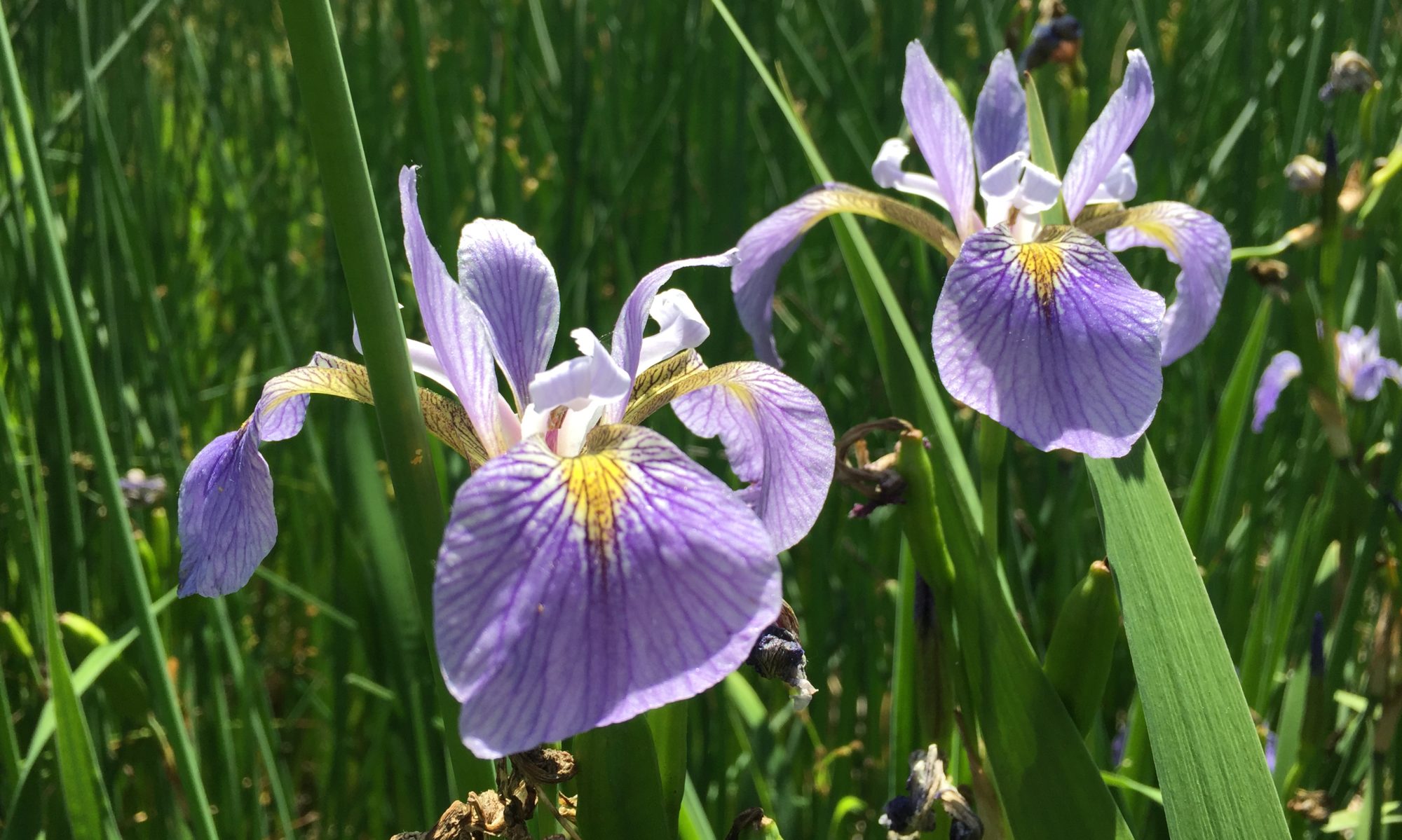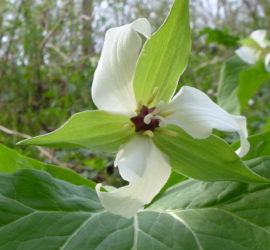LIRIODENDRON TULIPIFERA
IF YOU WANT TO SEE THESE TULIP POPLAR FLOWERS, YOU MAY NEED A PAIR OF BINOCULARS, BECAUSE THIS IS THE TALLEST BLOOMING TREE EAST OF THE MISSISSIPPI.

We have one growing in our backyard, and we get out on the roof with a pair of binoculars and we can get a good look at the flowers. Â Often times squirrels will chew on a branch and a flower will fall to the ground in one piece and we are afforded a good look. Â After a storm , whole branches containing flowers can be found in Morris Park. Â In the forest these trees grow very straight and tall, but if a tree grows out in the open it will send out branches low on the trunk to reach all of the available light. Â It will only grow straight and tall if it has to and it can. Â So, to view the flowers as they bloom on the tree, find a big field or meadow in an area where Tulip poplars grow. Â We were in West Fairmount Park on Chamounix Drive near Ford Road, parked across from the tennis courts where we found ours. Â The branches extended out far from the trunk and very low at the tips where the flowers can be found.

There is much to be admired about this native tree. Â It is a fast grower, and it can be helpful in restoring a degraded forest canopy. Â We anticipate that it will be an important ingredient in closing the canopy gaps of degraded woodland in Morris Park. Â While visiting The Mt Cuba Center in Delaware last Spring, they showed us a Tulip poplar they planted in their woodland Trillium garden 12 years prior in an effort to maintain a forest canopy. Â The tree was well on its way into creating the dappled shade much needed by Mt Cuba Center’s Trilliums and other woodland piedmont plants. Â Seeing this has helped us understand the importance of the Tulip Poplar in restoring a blighted urban forest.
The beautiful orange and white flower is to be admired as well, and today we are celebrating its bloom.

Here we can see the growth pattern of a Tulip Poplar in an open field environment. The v pattern is common for this tree, but this one has the divided trunk unusually low.
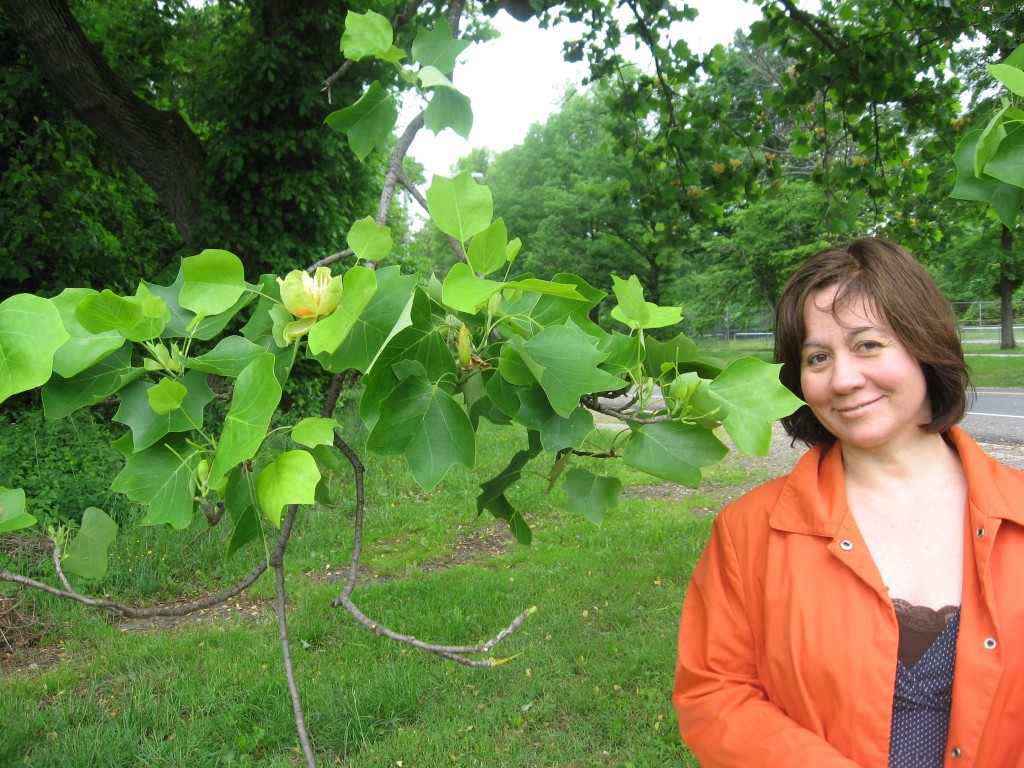
Isabelle dressed for the occasion.
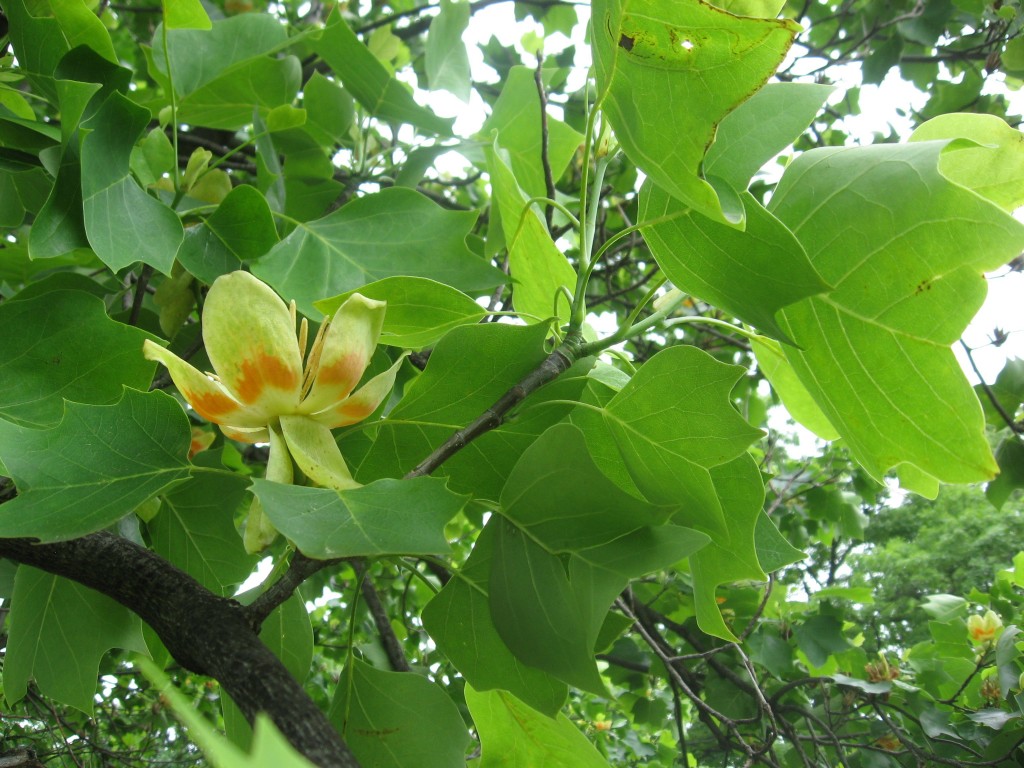
We were very disappointed to find out that  the Tulip Poplar was  “one of the least  productive forest species in terms of its ability to support wildlife-insects and vertebrates alike” (Bringing Nature Home, 2007, Douglas W. Tallamy, page 65). We also know that the Tulip poplar has become a dominant tree species in the forest since the American Chestnut has become blighted and reduced to a shrub. In Morris Park, there are numerous shrub specimens of the Chestnut (Castenea dentata), (Some reaching 25 feet in height) and there are large, mature stands of the Tulip Poplar.  The Tulip Poplar has for the time being, benefitted from the demise of the Chestnut tree.  So currently, the Tulip Poplar is able to seed itself abundantly and it has attained a dominant status in the forest: it is a species adapting to a forest out of balance.  The Chestnut Tree has for millions of years been the dominant tree in the forest.  We are just over only 100 years of Chestnut tree eradication from the forest canopy. The Tulip Poplar has taken over dominance in some areas of Morris Park.  The Oak trees that seem to have had a dominant role in the canopy seem to be on the decline.  There are fewer mid-sized oaks in the park than mid-sized Tulip trees and even fewer mature specimens.
However, there is an abundance of sapling oaks in one specific area very near our house. Â We have been sure to prioritize this area in invasive removal to give the oaks the utmost advantage in success.
One other concern about the Tulip tree’s increasing dominance is that if there were ever a disease that blighted the species, there could be a catastrophic loss of canopy in many forests. Â Morris Park would be severely effected.

The flowers  of the Tulip Poplar always stop us in our tracks.
Will this native forest tree continue to help  blighted urban and suburban forest remnants remain forested or will it outcompete other native forest trees such as oaks and beeches in an imbalanced charge to dominance?
We are now weeding saplings of this tree from our yard, and we are seeing more Tulip Poplar saplings than Oak saplings grow in the most disturbed areas of  the park. Is this tree on its way to being a prominent example of a native plant gone invasive in a disturbed ecosystem?
We often come across emotionally charged opinions about the issue of native plants, non-native plants, and even native plants that have become invasive. The opinions, even the sophisticated assertions about the status of a species, as well as the most thoughtful observations are still speculation until studied.
When these questions arise, we must turn to science for some answers. Â The scientists think about these questions all the time, and spend much effort devising ways to study these questions. Â All of these ways are carefully described in their published studies.
The Tulip Poplar has become a post-Chestnut forest tree, and we need to know what that means.
The tree remains a constant presence in our lives.  Its super straight and tall stature continues to impress us. We admire the dark green leaves, and the way the young  leaves open up, curled in a protective sheath until they are ready for the world.  The seed cones are impressive in their shape and the simplicity and elegance of its delivery system.
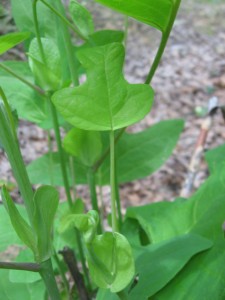
The flower is the most elegant and colorful. It is truly a beautiful tree.
Because its wood is soft and it has a tendency to break, this tree is best admired off in the woods and not recommended for planting near homes or as street trees.
Its grand size and soaring height can also give us a hint of what an American Chestnut must have been like before the blight.
